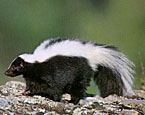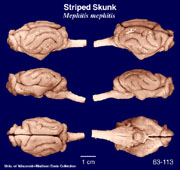|
Striped
Skunk
(Mephitis mephitis) #63-113 |
||||
|
|
Physical
characteristics and distribution
|
|
Striped Skunks are moderately small mammals with black-and-white fur belonging to the family Mephitidae and the order Carnivora. There are 11 species of skunks, which are divided into four genera: Mephitis (hooded and striped skunks, two species), Spilogale (spotted skunks, two species), Mydaus (stink badgers, two species), and Conepatus (hog-nosed skunks, five species). Skunk species vary in size from about 15.6 in. (40 cm) to 27.3 in. (70 cm) and in weight from about 1.1 lbs. (0.5 kg) (the spotted skunks) to 9.92 lbs. (4.5 kg) (the hog-nosed skunks) They have a moderately elongated body with reasonably short, well-muscled legs, and long front claws for digging. Although the most common fur color is black and white, some skunks are brown or gray, and a few are cream-colored. All skunks are striped, however, even from birth. They may have a single thick stripe across back and tail, two thinner stripes, or a series of white spots and broken stripes (in the case of the spotted skunk). Some also have stripes on their legs. Striped Skunks are omnivorous, eating both plant and animal material but mostly meat. They eat invertebrates (insects and their larvae, found by digging, and earthworms) as well as small vertebrates (rodents, lizards, salamanders, frogs, snakes, birds and eggs). Striped Skunks are solitary animals when not breeding, but may gather together to keep warm in communal dens in the coldest part of their range. During the day they shelter in burrows that they dig with their powerful front claws, or in other man-made or natural hollows as the opportunity arises. Both sexes occupy overlapping home ranges through the greater part of the year; typically 2 to 4 km for females, up to 20 km for males. Striped Skunks are nocturnal. They are best-known for their ability to spray a foul-smelling and sticky fluid as a defense against predators; this secretion comes from the anal scent glands. Striped Skunks inhabit Canada (SW Northwest Territories to Hudson Bay and S Quebec), Mexico (N Tamaulipas, N Durango, and N Baja California), USA. |
|
Description
of the brain
|
|
Animal
source and preparation
|
|
All
specimens collected followed the same preparation
and histological procedure.
|
Other Related Resources (websites and publications)



